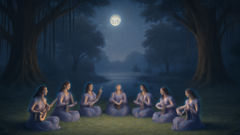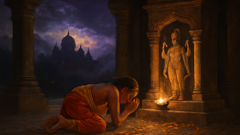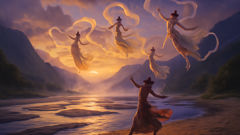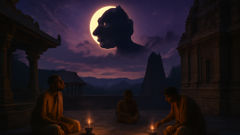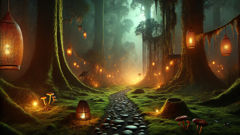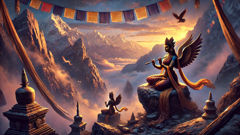Introduction
Under a sky where the moon poured like silver onto river and canopy, the Gandharvas sang. They were not merely the makers of music; they were music’s attendants, its secret grammar, its wandering echo. In the oldest hymns, before cities tightened their stone ribs and before kings drew lines on maps, these male nature spirits lived in the liminal places—on riverbanks where light hesitated, in the crowns of fig trees where roots remembered rain, beside pools that mirrored the cosmos. Their tools were veena and flute, cymbal and voice; their craft made seasons feel deliberate and grief feel less final. They moved like wind between gods and humans: messengers bearing vows, witnesses at the births of heroes, and companions to those who listened closely enough to hear the world’s song. Their names—Chitraratha, Citraratha, Tumburu among them—were spoken like blessings and sometimes like warnings. In this retelling I invite you into their forested courts and dawn-lit stages, to listen to their tunes and to trace how their stories shaped ritual, art, and the sound-world of the subcontinent. You will meet their myths from Vedic stanzas to Puranic epics, discover the instruments and images that mark them in temple reliefs and folk songs, and follow one imagined journey that shows how a Gandharva’s music can cross a human wound: music as bridge, as messenger, as medicine. The account that follows blends careful cultural context with imaginative scenes crafted to revive the Gandharvas’ presence—because these spirits, though ancient, still move in the margins of modern memory whenever a veena is tuned, a river flows, or a late-night flute bends a note toward the stars.
Origins and Echoes: Gandharvas in Veda and Purana
The earliest echoes of the Gandharvas come from the Vedas, where the word itself shifts like a note across texts. In Vedic hymn and hymn-compiler’s memory they appear less as fixed personalities than as a collective—celestial beings tied to sound, to rites of passage, and to the movement of gifts and messages. This is not a dry catalog of names; rather, it is a living acoustic history. Imagine an ancient seer tuning his breath to the cosmos, listening for the precise pitch that sets a prayer in motion. In that listening he hears the Gandharvas—part of the cosmic chorus that keeps the sacred order. Their function is doubled: they celebrate the gods and act as emissaries between heaven and earth. Over centuries, as myth thickened into tale, individual Gandharvas took on more elaborate identities. Tumburu and Chitraratha appear as named virtuosos, each with a distinctive instrument, demeanor, and courtly role. Where Vedic reference hints at their participation in ritual, later Puranic stories drape them in biography: they fall in love, they quarrel, they challenge gods and demons, and occasionally they are punished or exalted in ways that reveal cultural anxieties about desire and loyalty.
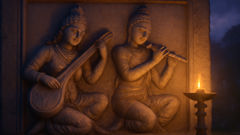
A closer look at their instruments illuminates both the Gandharvas’ mythic role and their cultural legacy. The veena—an instrument of long neck and resonant body—becomes an emblem of their refined art. In some stories a Gandharva’s veena is made by the divine artisan Vishvakarma, or carved from a branch of a wish-fulfilling tree. Flutes, with their breath-bent melody, link Gandharva music to the untamed world: wind, birdsong, and river-cadence. Cymbals and small drums mark celebratory rhythms and the pulse of ritual. Archaeological finds and temple carvings across India preserve these instruments in stone—figures playing stringed instruments with the same concentration a modern performer would show—suggesting continuity of musical sensibility. When temple panels show a Gandharva leaning into a note as if to buoy the devotee’s prayer, those artisans were not rendering mere myth; they were preserving a theology of sound in which music itself is sacrament.
Beyond instruments, Gandharvas have social and moral roles in the corpus of stories. They officiate at Gandharva marriages—union by consent and song, distinct from arranged marriages in social practice. A Gandharva marriage in myth is often invoked as the archetype of a bond formed by mutual attraction, witnessed by the trees and stars rather than human kin. This notion persisted in folk memory and even influenced some historical marriage practices that recognized elopement or unions formed outside strict familial sanction. The Gandharva, then, becomes a symbol of love’s sovereignty yet also of its potential conflict with society. Many tales show Gandharvas as liberators of joy, yet subject to tests: kings who offend celestial etiquette, sages who punish hubris, or demons who steal songs. Their ambivalent position—wedded to nature, yet often allied with the gods—makes them capable of both mischief and mercy.
The Puranic narratives build on these seeds. In some accounts Gandharvas are born of celestial unions or as attendants of Indra, the storm-king. They sometimes serve in royal courts of gods, performing to keep the cosmic order’s mood buoyant. At other times they stray into human worlds to challenge mortals to contests of skill, to seduce kings and sages, or to confer blessings. Their interactions with rishis and ascetics form an important motif: the Gandharva’s music can soothe a disturbed mind, or it can be a test of discipline for a practitioner whose vows are threatened by the allure of beauty and sound. These episodes are didactic, not simply entertaining; they instruct about the balance between aesthetic pleasure and spiritual rigor.
Art history and devotional literature carry these stories forward into visual and performative traditions. South Indian temple pillars show winged Gandharvas dancing above mythic battle scenes; miniature paintings of medieval courts depict them visiting palaces to play for gods and kings. Classical Sanskrit drama and later devotional ballads borrowed their imagery, making the Gandharvas mediators of emotional tone in literature as well as ritual. Indian classical music, with its intricate systems of raga and tala, echoes the Gandharva idea: that specific modes of sound can align inner life with outer world. Musicians were sometimes thought to be Gandharva-adjacent—transmitters of a celestial craft—especially when their music caused rapture or transformation.
To the anthropologist, Gandharvas are language for liminality, for spaces where the sacred and the everyday leak into one another through sound. To the musician, they are an ancestral lineage. To the devotee, they are witnesses to vows, carriers of offerings, and celebrants at the threshold of the holy. Across centuries, the Gandharva motif adapted without losing its core: beings whose essence is music and whose work is to move between realms. That mobility—geographical, social, and spiritual—made them useful symbols in stories where the boundaries between human and divine are contested and negotiated.
Yet the Gandharvas are not static figures trapped in ancient pages. Their stories have been told and retold, reimagined in village songs, temple plays, and the modern imagination. In every retelling, music remains the center. Whether through a sage’s hymn, a royal chorus, or a lone flute in a forest, the Gandharva’s presence is announced by a note that refuses to vanish. And that fidelity to sound is why their myths survived: because human ears continued to crave the shape of the heavens, a craving that the Gandharvas embodied and sang back to the world.
Music as Messenger: Stories, Rituals, and a Gandharva's Journey
If the first section traced the Gandharvas’ place in texts and temple stone, this next section immerses us in their lived imagination—how music journeys, how sound becomes a language between worlds. Stories of Gandharvas often hinge on a single note, a message carried on a melody, or an encounter where a mortal learns to listen differently. To bring such motifs to life, I offer a blend of cultural commentary and an original narrative vignette that models the Gandharva’s method: entering human grief with a tune and leaving a transformed silence.
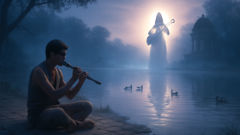
Across the subcontinent, ritual practices summon the Gandharva idea without always naming it. In folk rituals that accompany sowing or harvest, musicians may invoke celestial patrons to bless the crop; the cadence of their drums and the pitch of their strings are requests for fertility and protection. In marriage rites, the concept of a Gandharva union—contractless, consent-based—haunts formal ceremonies as a reminder of love’s autonomous force. Devotional songs to gods and goddesses sometimes include references to Gandharvas as chorus members, celebrating a deity’s grace. Classical music concerts traditionally begin with an invocation—'avarana' or 'vandana'—a gesture that places the music within a sacred continuum. The performer, in these frames, becomes both artist and emissary, a living Gandharva who negotiates emotions in a public space.
Now imagine a village by a wide, slow river whose name has been changed by time. In the village lives Aruni, a young player of the flute whose hands betray a tenderness for small things: the way a reed splits a note, the way dawn tastes of jasmine. Aruni plays for festivals and funerals; her music has the reputation of making even the hardest hearts look away to the water. One season, the river lowers and the monsoon delays; a drought makes the village’s cattle thin and the crops falter. The elders watch the sky and the priests chant for rain, but the river refuses any answer. There are old whispers of celestial patrons who can be asked for help: a song offered at the banks, a tune carried up through the canopy to where the Gandharvas sit in their unseen court. Aruni is chosen, younger than the others but known for the way her music reaches birds. She goes at dusk to the river edge, breath wrapped around a bamboo flute that has been blessed by a passing monk. Her call is not only to gods; it is to the liminal beings who might accept such an offering.
As she plays, the world thins to the flute’s line. The villagers wait at the bank, children cupped to ears, old women clutching prayer-strings. The first notes are modest— a raga that maps longing and lullaby. The flute bends like water around stone. Somewhere in the treeline a rustle answers, soft at first and then sure. A figure steps from behind a banyan root: he is luminous but not blinding, his skin the color of river-stone, his hair threaded with dew, a veena slung like a second weathered heart. This is the Gandharva Chitraratha—named in some old lists, but here present as music’s emissary. He does not speak with words. His arrival is a modulation: the air shifts into a key that contains both comfort and firmness. The villagers’ breath changes; cattle in the distance lift their heads.
Chitraratha listens for a long time. Aruni does not falter; she treats the Gandharva’s silence as part of a duet. When she pauses, he answers with a single, low resonance on his veena—an interval not common in village music, a microtone that slides like a raincloud. Immediately, the villagers feel as if a letter of their sorrow has been read aloud. Chitraratha’s music is not a balm that erases suffering. It is a clarifying torch: it allows grief to be held, and it opens channels for what must be done. Under his guidance, Aruni learns a new phrase that maps the river’s mood, a rhythm that mimics the subterranean flow of water. Together they play through the night, and by dawn the horizon paled with thin light; rather than call down rain outright, the duet taught the people a way to listen: to dig a subterranean channel, to chant a particular cadence while scaring crows from the seeds, to plant the last row with seeds wrapped in music and prayer.
The result is not immediate miracle but a steady change. Seedlings root where few expected them to, and the river swells slightly after a distant cloud breaks. The villagers remember the night as the point where they ceased trying to command the sky and instead learned to negotiate with the landscape. They told their grandchildren about the veena-lined visitor who came with a single purpose: to show how music can teach technique and temper grief. In many such stories the Gandharva’s role is pedagogical rather than purely supernatural. He instructs—often indirectly—teaching humility, cooperation, and attentiveness to nature’s subtleties.
The Gandharvas’ moral repertoire is broad. They can be protectors of sacred rites, but they can also be unruly lovers who disrupt asceticism. A recurrent tale concerns a pundit whose renunciation is tested when a Gandharva’s music arouses dormant desire. The narrative is rarely about condemnation as much as about restoration: the sage must re-learn balance. Another cluster of tales shows Gandharvas rescuing stolen songs from demons or retrieving sacred objects, traveling between heavens and human markets. In each, music is the currency and the map; melody carries intention and can change allegiance. The Gandharva’s ability to cross boundaries—gendered, social, spiritual—makes them apt characters for stories that teach adaptability.
Ritual specialists and performers across India have harnessed Gandharva imagery to frame ethical and aesthetic ideals. A musician might be called 'Gandharva' in praise, not as literal claim but as recognition: you play with such clarity that you seem touched by the heavenly court. Temple dancers whose footwork conjures seasons are called 'Gandharvi' in some regional lore, female counterparts imagined as attendant spirits. Folk theater uses Gandharva characters to introduce comic relief or moral tension; young lovers in village plays sometimes adopt Gandharva names as they enact elopement scenes, invoking that tradition of consent-based unions.
Anthropologists and historians read these stories for what they tell about how communities integrate art into life: music as ceremony, as social technology, and as a way to preserve ecological knowledge. In many drought narratives, musical prescriptions for planting and water management circulate for generations as practical rituals cloaked in sacred form. Thus, the Gandharva’s song becomes a repository of environmental wisdom—a melody that encodes when to plant, when to harvest, when to rest the soil.
If the Vedas gave the Gandharvas cosmic function and the Puranas dramatized their humanity, it is in lived ritual and imaginative retelling that they remain present, adaptable figures. They are at once music’s metaphysics and its practical pedagogy, a reminder that sound can move beyond pleasure to become technique, covenant, and counsel. Whether carved in temple stone, sung by a village bard, or imagined by a solitary flutist at a river bank, the Gandharvas continue to teach a simple, stubborn lesson: to listen well is to be able to act well.
Conclusion
The Gandharvas remain an incantation for our capacity to hear life as sacred contest and delicate covenant. Across millennia they have served as a cultural vocabulary for the relationship between beauty and duty, between desire and discipline, and between human longing and the mutable generosity of nature. They remind us that music is never merely entertainment: it carries instruction, memory, and repair. When we read their names in texts or see their carved forms in temples, we should not think only of antique lore; instead, we should listen for how their presence lingers in everyday practice—in village rituals that plant songs with seeds, in classical invocations that prepare a musician’s heart, in the private act of playing to the river or sky. To call someone a 'Gandharva' is to recognize their capacity to translate the world’s weight into something audible and transformable. Their stories press a question upon every listener and performer: will we use music as a bridge—to make messages cross, to heal small and large wounds, to teach hands how to tend soil, to help a heart breathe again? The old answers remain serviceable. Play with care. Listen as if your life depends on it. Invite the liminal in. In doing so we keep the Gandharvas’ craft alive: not as museum pieces but as living sound, a lineage of notes that continues to pass, from throat to instrument to wind, into the listening world.

